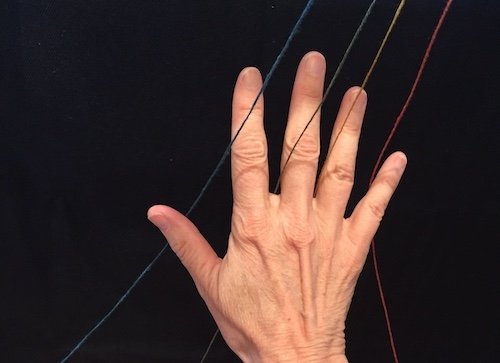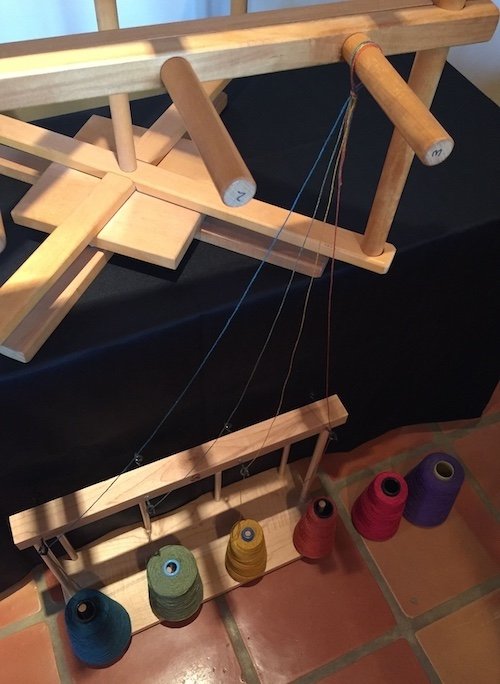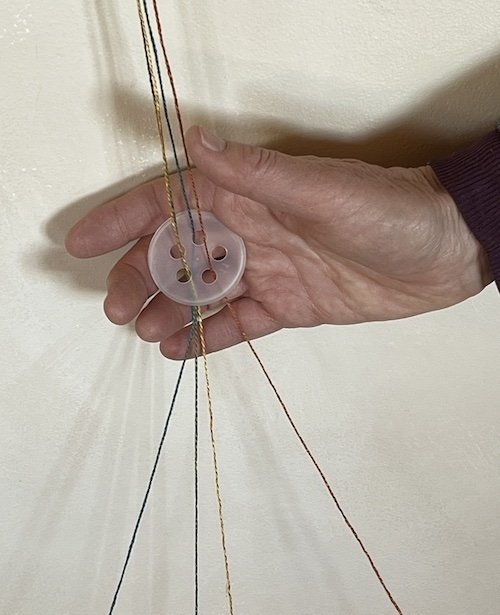Just the Right Number of Fingers
Fairly early on as a new weaver, I learned that if you are creating a warp that has two colors alternating with each other, it is far easier and faster to wind with two strands of yarn in your hand than one at a time, cutting off and retying after each one. Once you get used to it, the process becomes so automatic that it’s almost harder to go back to winding with a single strand. In fact, if I am winding a single-color warp I will nearly always use two identical cones of yarn and wind with two strands together.
The important thing here is that you need to keep one of your fingers between the two strands of yarn as you wind. Otherwise, they end up twisting around each other barberpole fashion and then you have a tangled mess as you wind your warp onto your loom. But if you keep them separated from each other, either with your fingers or a warping paddle, or with some other device, they have no opportunity to do that and they stay parallel throughout the winding process.
Needless to say, this skill comes in very handy with doubleweave, because you always have two warp threads going at a time unless you are winding your two warps spearately and then putting them together on the loom. For the past ten years or so I have been doing a lot of color rotation in doubleweave, with four different colored warp threads going at a time in each section of my warp. With a little practice I have become quite adept at holding those four threads in my hand as I wind my warp, with one finger in between each of them.
I have a nice setup, with a Leclerc cone holder that has space for eight cones of yarn. This holds the cones upright and keeps them from falling over as you wind, and the ends of the yarn get threaded through pigtail screw eyes that keep the strands of yarn running parallel to each other.
You can make one of these yourself fairly easily, although I have heard that it is next to impossible to find these open-ended screw eyes that aren’t too large. The open-ended ones are nice because you can move a cone of yarn from one position to another without having to cut the ends. But the closed-end screw eyes work just fine too, and it is no big deal to cut and tie on new ends. I’ve read that there are Swedish cone holding stands that have two levels of screw eyes that do a great job of keeping the threads separated, but I haven’t been able to find one.
I gather the four warp ends that I am working with and tie them all together in one overhand loop that goes on to my starting warping peg. I then position my hand so that the four strands fall right in between each of my fingers.
Once the warp strands are in place, I close my hand into a fist so that they can’t escape, and I’m ready to start winding. As you wind it is important to keep the hand that is holding the warp ends in the same parallel position as it moves alond the path of the warp without twisting and turning. The other hand can guide this hand as it goes around all of the pegs and over and under the cross.
It isn’t at all necessary to worry about having the four warp ends lay in the correct order as you go over and under the cross. That will all get sorted out once the warp is wound on the loom and you are threading the heddles. Since the hand holding the warp ends has kept them parallel throughout the winding process they won’t get twisted around each other. If this bothers you, you can use a warping paddle instead to keep the warp ends in thread-by-thread order at the cross, but this has never created a problem for me. You will get a little half-twist each time you go around the top or bottom end peg, but since those ends don’t get woven it doesn’t make any difference.
Several years ago I taught a workshop at the straw bale barn studio that the lovely Thorne sisters have in central California. Kay told me that she learned a system from Norman Kennedy where you can wind up to 96(!) warp ends at once with a thread-by-thread cross. This sounded impossible to me, but she demonstrated the process using eight ends together with spools on a spool rack. She had me do it myself and I did succeed making one or two rounds with her guidance, but I think it would take me at least a few dozen more times before I would get the hang of what you do with your hands as you make the turn at the cross. It was pretty amazing, but you do have to have a large spool rack and you have to wind as many spools as you are going to be using.
When I teach my Double Rainbow workshop I have my students wind their warps with four strands at a time and periodically change one of the four strands. This can feel quite awkward if you’ve never done it before, but it soon becomes a muscle memory and goes very quickly once you get the feel of it. For some people, however, maybe because their hands are smaller or because they have arthritis, the process just doesn’t become comfortable. A warping paddle can take care of this, or laying a reed along the bottom row of a warping board and threading the ends through four separate dents in the reed.
Students have come up with a number of other ingenious alternatives for keeping the four warp ends separated as they wind their warps. Four flower pots turned upside down with the end of the yarn coming through the holes works. Putting the ends through separate slats of a wooden chair works. One student put her four cones underneath a plastic shower chair and put the four ends through holes in the seat.
Another student came up with the very simple and elegant solution of taking the plastic cap from a spice bottle and threading the warp end through the holes. It’s very easy to just hold the cap in your hand and follow along the path that the warp takes, again, being careful to not be twisting and turning your hand as you go.
I have a video on youtube where I demonstrate my process of winding with four colors at once. Here is the link if you would like to watch it - .
I often tell my students that we have just the right number of fingers to wind a warp with four ends at a time, just by holding them in our hands - and I say this a couple minutes into this video as well. A few years ago I was teaching a live workshop and walking around the room. When I got to one of the women in the class she said “You know how in your video you said that we have just the right number of fingers to wind this warp?” I said “Yes?” She held up one of her hands, and on it were six perfectly formed fingers!
May you have great success in winding multi-strand warps, whichever system you choose to use, and however many fingers you have!







